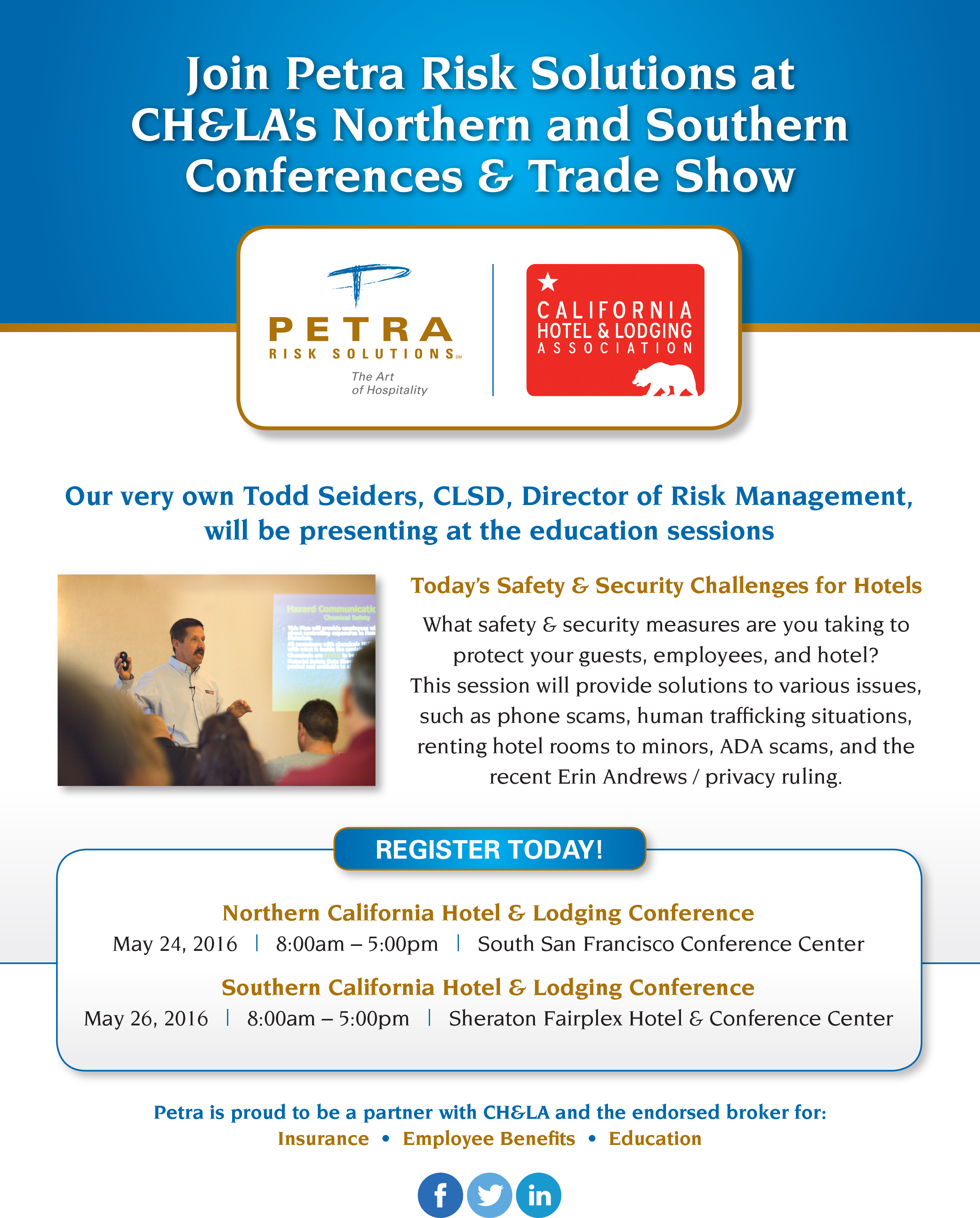
For more information on the Northern California Hotel & Lodging Conference, click here!
For more information on the Southern California Hotel & Lodging Conference, click here!

For more information on the Northern California Hotel & Lodging Conference, click here!
For more information on the Southern California Hotel & Lodging Conference, click here!
Comments Off on Join Petra Risk Solutions at CH&LA’s California Conferences
Filed under Conferences, Hotel Industry, Management And Ownership, Risk Management, Technology
This year’s Asian American Hotel Owners Association convention was all about success and how to achieve positive performance in an era of new brand launches, generational leadership change, and external disruptors.
Mike Leven, president and COO of Las Vegas Sands Corporation and an original organizer of what would become AAHOA, kicked off Thursday’s general session with a call to action for the rising tide of second-generation Asian-American hoteliers who are growing their own footprints in the business.
“What happens when you are successful?” he asked. “You stop doing what made you get there in the first place, and that’s where the danger comes in.”
Leven said that as the industry faces change, the next generation of leaders must change with it, especially if they hope to be successful during downturns.
“The status quo is a prescription for failure,” he said. “You have a responsibility to continue to be dynamic in the search for change, for doing things different, for not being satisfied.”
Hotel franchise company executives echoed those statements on Thursday’s “Industry CEOs” panel and encouraged members to continue to be involved in their franchise organizations and the larger industry.
The CEOs shared insight into consumer trends, highlighting why creating excellent guest experiences will translate into strong bottom-line performance.
“We see people choosing experience over product—we see this in retail, in consumer products and certainly in travel,” said Mark Hoplamazian, president and CEO of Hyatt Hotels Corporation. “The idea that the product has to be perfect is weakening. Instead, people are looking for a holistic, experiential time.”
He advised attendees to make sure they’re creating those shareable experiences for guests.
Hilton Worldwide Holdings President and CEO Chris Nassetta echoed that sentiment that guests are all about experience these days. He told attendees that creating positive cultures at the hotel level are what will make those experiences great.
For more: http://bit.ly/1RXFL3R
Comments Off on Next-Gen Leaders Must Be Open to Change
Filed under Guest Issues, Hotel Industry, Maintenance, Management And Ownership, Social Media, Technology, Training

By now I’m sure most of us have completed our 2016 budgets, but how many of you have started strategic discussions about the effect the proposed overtime regulations in the United States could have on your hotels?
If not, now is the time to start.
On 30 June 2015, the U.S. Department of Labor released its proposed changes to the overtime regulations under the Fair Labor Standards Act. If adopted, these changes will affect roughly 4.6 million current salary-exempt employees. While this will affect all segments of the American workforce, given the pay scales of our industry, hoteliers will be significantly affected by these changes, making more employees eligible for overtime compensation.
Under the current regulations, to be eligible for the overtime exemption employees must meet the duties and responsibilities tests under one of the administrative, executive, professional and/or computer professional exemptions. In addition, they must be paid a minimum weekly salary of at least $455 per week (or $23,660 per year).
The new federal overtime plan would increase the minimum weekly salary of $455 per week to $970 per week or $50,440 per year, a 113% increase. This change also would include automatic periodic increases to the salary threshold.
This means that regardless of the duties and responsibilities test, if a salaried employee makes less than $970 a week, he or she would no longer be considered exempt for overtime compensation. Hours would need to be tracked and overtime paid for every hour worked in excess of 40 per week.
As a leader in the hospitality industry, this should have your full attention.
The comment period for the proposed changes ended 4 September 2015, and we should expect to receive the final ruling sometime early to mid-2016. Once released, the changes will be effective within 60 to 120 days. And while we don’t know whether the DOL will adopt the current proposal or bring a new idea to the table, we should expect some changes to the salary threshold, as its last increase was in 2004.
For more:Â http://bit.ly/1maZAWV
Comments Off on Are you ready for overtime changes?
Filed under Employee Benefits, Finances, Hotel Employees, Hotel Industry, Labor Issues, Management And Ownership

Following the nationwide EMV liability shift on Oct. 1, in-person credit card transactions in the United States are safer and more secure than ever before. Instead of swiping a credit card, vendors will be required to scan a high-tech chip that creates a unique code for each transaction. This means consumer information will be more difficult to duplicate, leading to increased data safety. Additionally, the widespread use of EMV (Europay, MasterCard, and Visa) microchip technology protects vendors—including hoteliers—from liability in cases of fraud. And, now that the country has finally caught up with global security standards, the long-term maintenance and success of the program is of the utmost importance.
According to Karen Cox, vice president of payment and retail solutions at Toronto-based payment processor, Moneris, U.S. vendors are in a very advantageous position as this solution spreads throughout the country. “Because the United States adopted EMV technology after other major markets, there have already been solutions developed for common issues, making the process easier,†she explains.
Most properties have already installed the POS hardware that include chip readers, but as the new EMV systems are fully integrated, hoteliers may need to add new processes during transactions. “You have to prove that the card is at the hotel for the transaction, so even if guests book with a credit card online, they may need to present the card during check-in and either sign or enter their PIN,†Cox says.
However, once the system is adopted and processes have evolved to facilitate the technology, keeping EMV technology up to date should not be an issue for most hoteliers. “The chip technology is very solid,†Cox describes. “There will likely be software updates, but if the properties keep up with the regular maintenance and renewal processes, they shouldn’t have any issues.â€
While some hotels may not be using EMV technology yet, Cox recommends that these entities implement the systems as soon as possible. She adds that hoteliers who don’t know where to start should partner with a provider that can provide end-to-end solutions for the EMV shift.
For more:Â http://bit.ly/1N6JVAS
Comments Off on Credit Card Switch: Is Your Hotel Compliant?
Filed under Guest Issues, Hotel Industry, Management And Ownership, Risk Management, Technology
With the Thanksgiving weekend behind us, attention turns to celebrating with family, friends — and coworkers at the company holiday party.
A majority of organizations are still planning to hold holiday or end-of-year parties; however, a growing number of employers are cutting back, according to a recent survey from the Society for Human Resource Management. The survey found that almost two-thirds (65%) of human resource professionals said their organizations would host a party for all employees. But 30% of respondents said that no party was planned at their organization, an increase of 13 percentage points from 2012.
How and where will those companies celebrate? A majority — 67% — of respondents said their party would be off site, and 22% said they would close early that day. More than half (59%) said alcohol would be served at the party. Of those planning to serve alcohol, 47% indicated they would regulate alcohol consumption at the event, with 71% using drink tickets or having a drinks maximum.
Employers are concerned about possible repercussions from employees drinking too much, for example:
  • Drunk driving and possible motor vehicle accidents.
  • Workers compensation for falls and other injuries.
  • Discrimination claims, including sexual harassment and religious
   discrimination.
  • Injury to third parties.
  • Premises liability.
  • Underage drinking.
In addition to employer-based liability, many organizations are concerned about their “social host†liability as well. In some states, social host liability is limited to people hosting parties at which minors are served alcohol. In other states, employers may be liable for underage drinking at work functions, and there are still other states in which the law is less clear. The safest action is to develop a policy and guidelines, with advice from your legal counsel and input from the human resources department, then distribute that policy to all employees.
For more:Â http://bit.ly/1ODgF55
Comments Off on 7 Tips to Reduce Holiday Party Liability for Employers
Filed under Hotel Employees, Hotel Industry, Insurance, Liability, Management And Ownership, Risk Management
According to a report released this week from Hiscox, businesses in the Golden State are 40% more likely than their peers to be sued by an employee. In fact, just four states – New Mexico, Nevada, Alabama and Washington, DC – outstrip California when it comes to employee lawsuits.
The reasons why are complicated, but report authors suggest that state laws going beyond federal guidelines are the most likely cause of discrepancies in the rate of employee lawsuits between states. When it comes to California, that means strict regulation around anti-discrimination and fair employment practices that subject businesses to higher scrutiny from workers.
Discrimination, as defined by these laws, comes in many forms including age (over age 40), disability, national origin, race, color, religion, sex (including pregnancy) and genetic information (diseases or disorders in family medical history).
More clear is the effect such lawsuits have on businesses. According to Hiscox, the average legal dispute regarding an employment matter lasts 275 days and in 19% of cases, defendants are subject to a defense and settlement payment. When that happens, businesses can expect to bill their insurers an average $125,000 in claims while taking $35,000 in deductibles on themselves.
The report comes just months after a similar survey from Littler Mendelson, in which 57% of human resource and C-suit professionals said they expect workplace discrimination claims to become one of the top business risks in the next years.
The statistics are a serious argument in favor of ample employment practices liability insurance (EPLI) for California businesses. Without proper coverage, clients could end up on the hook for an extra $90,000, going by national averages. Inadequate limits could also cause a sting, though arguably less of one.
For more: http://bit.ly/1OshHAO
Comments Off on California Businesses 40% More Likely to be Sued by Employees
Filed under Claims, Hotel Employees, Hotel Industry, Insurance, Management And Ownership, Risk Management
The current hostage situation at a Radisson Blu in Mali dredges up memories of the Mumbai, India terrorist attacks that took place in November 2008, which targeted a number of buildings, including the Taj Mahal Palace & Tower Hotel and the Oberoi Trident Hotel. At the time, LODGING reported on how to prevent and prepare for such attacks with advice from Kyle Olson of the security consulting firm the Olson Group. In light of recent events, here are a few tips he shared that are still relevant today.
Routinely change up security patterns and practices, and make the fact that you do so apparent; this will create uncertainty in potential attackers, and encourage them to look for a more “reliable†victim. Remove information from your web sites that isn’t essential, but which makes you vulnerable. Instead of detailed floor plans, use generalized, simplified drawings that don’t provide information on exits and serviceways; make intelligence collection harder. Move furniture and display fixtures in public areas around, change things up outside the hotel and inside, so that it is more difficult for an attacker to choreograph movements. Train personnel—security and staff—to recognize the difference between someone killing time and timing a kill. And teach them what to do when they think they have identified a potential bad actor.
Objectively assess the hotel’s vulnerabilities, and routinely review that assessment, particularly in light of special/large events. “Red Team†how someone could attack and consider how to counter. Where do you shelter people? Is the staff trained to get people to safety/exits? Is the critical information that will be needed by public safety—guest registers, employee rosters, floor plans—readily at hand?
The hotel’s plan must also reflect the plans, procedures and, above all, the needs of the local response agencies. Are hotel security and management personnel trained in the terminology of the National Incident Management System (NIMS)? NIMS is the language the cops, firefighters, and Feds will be speaking in a crisis. Remember, if the management team in the hotel is not able to plug into the response by public safety agencies with both information and understanding of the procedures being used, they will be marginalized. If hotel leadership is not seen as part of the solution, they will be considered part of the problem. If they are not able to engage constructively, they will have no influence in shaping the outcome of their property. If, on the other hand, they are seen as bringing value, their counsel will be sought out and they will have a hand in managing events.
Hotel personnel need to practice what their actions would be in a serious incident. This means knowing the plan, understanding their roles, and testing that understanding in exercises. These do not need to be complex, but they do need to be serious opportunities to evaluate the readiness of the hotel’s team. Ideally, the hotel should invite local public safety personnel into the exercises, to play out their roles. Not only will this provide hotel personnel with a sense of what will be expected of them, but it will provide an opportunity for the hotel personnel to demonstrate that they take the challenge seriously and that they have something to offer.
For more:Â http://bit.ly/1MH0jFN
Comments Off on Preventing and Preparing for Terrorist Attacks
Filed under Hotel Employees, Hotel Industry, Management And Ownership, Risk Management, Training, Uncategorized
Employees can make or break businesses in the service industry. While customer service oriented employees create a luxurious experience at a lesser establishment, employees that don’t prioritize customer service can ruin a guest’s experience even at the most finely-appointed hotel.
However, managers and supervisors cannot always be present to recognize and reward desirable service practices, nor can they always be present identify and correct poor practices. With so many points of customer and employee interaction, surveillance is one of the most effective methods to safeguard employee safety and integrity, review employee performance, identify training points, and document “HR issues.†Of course, too much of a good thing can be a problem.
Employers must understand the difference between valid surveillance and illegal intrusions on privacy rights before taking advantage of video/audio recordings. This article aims to help employers stay on the right side of that fence.
The law regarding privacy in the workplace was most recently defined by the California Supreme Court case in Hernandez v. Hillsides, Inc. The rule is subjective, yet straightforward—employers must not engage in any activities that would violate an employee’s “reasonable expectation of privacy.†This helps determine the degree to which a person can reasonably expect to be left unmonitored, but the problem is that it is a nebulous standard that relies on “widely accepted community norms.â€
There are some obvious places an employee or guest will reasonably expect privacy, for example, in a bathroom stall. However, courts will look at several considerations to determine the reasonableness of an individual’s expectation of privacy, such as the customs, practices, and physical settings of the workplace. Other considerations include where the surveillance equipment will be placed, when it will be active, and who will have access to recorded data.
The time and place of activities is another important factor. This includes an inquiry into the physical layout of the area being monitored, whether the area is restricted access, limited from view, or reserved for performing bodily functions and other personal acts. On the other hand, if an area is open and accessible to coworkers or the general public, or work is performed in the area, employees are unlikely to have a reasonable expectation of privacy.
Courts will also consider who has access to any recordings or videos to determine the severity of an alleged invasion of privacy. In fact, even if an employer collects monitoring information legitimately, an employer may be subject to liability if the information can be accessed by the wrong people. A non-managerial employee should not have access to a recording of his or her co-worker. If the purpose is to monitor customer service performance, only managerial employees should have access. For this reason, employers’ must carefully control who has access to any monitoring data.
For more:Â http://bit.ly/1Nc7CLd
Comments Off on What You Should Know Before Monitoring Your Employees and Guests
Filed under Employee Practices, Guest Issues, Hotel Employees, Hotel Industry, Management And Ownership, Risk Management, Technology

On November 2, 2015, the FCC issued two separate news releases on Wifi blocking. In one action, the FCC announced a $718,000 fine against M.C. Dean, one of the nation’s largest electrical contracting companies, for blocking personal mobile “hotspots†of convention visitors and exhibitors who tried to use their own data plans at the Baltimore Convention Center to connect to the Internet rather than paying M.C. Dean substantial fees to use the company’s Wifi service.
According to the FCC, as the exclusive provider of Wifi access at the Baltimore Convention Center, M.C. Dean charges exhibitors and visitors as much as $1,095 per event for Wifi access. Last year, the Commission received a complaint from a company that provides equipment that enables users to establish hotspots at conventions and trade shows. The complainant alleged that M.C. Dean blocked hotspots its customers had tried to establish at the Baltimore Convention Center. After receiving the complaint, FCC Enforcement Bureau field agents visited the venue on multiple occasions and confirmed that Wifi blocking activity was taking place.
The Enforcement Bureau’s investigation found that M.C. Dean engaged in Wifi blocking at the Baltimore Convention Center on dozens of occasions in the last year. During the investigation, M.C. Dean revealed that it used the “Auto Block Mode†on its Wifi system to block consumer-created Wifi hotspots at the venue. The Wifi system’s manual describes this mode as “shoot first, and ask questions later.†M.C. Dean’s Wifi blocking activity also appears to have blocked Wifi hotspots located outside of the venue, including passing vehicles. The Commission charged M.C. Dean with violating Section 333 of the Communications Act by maliciously interfering with or causing interference to lawful Wifi hotspots.
In a separate announcement, unrelated except as to the subject matter, the FCC proposed a $25,000 fine against Hilton Worldwide Holdings, Inc. for “apparent obstruction of an investigation into whether Hilton engaged in the blocking of consumers’ Wifi devicesâ€. A consumer complaint alleged that Hilton was blocking visitor’s Wifi in Anaheim, California in order to force them to pay a $500 fee to access Hilton’s Wifi. Other complaints alleged similar Wifi blocking at other Hilton-brand properties.
In November 2014, the FCC Enforcement Bureau sent Hilton a letter of inquiry requesting information concerning basic company information, relevant corporate policies, and specifics regarding Wifi management practices at Hilton-brand properties in the United States. After nearly one year, Hilton has failed to provide the requested information for the vast majority of its properties. The proposed fine and announcement to Hilton included a demand to immediately provide the essential information and documents about its Wifi practices, and warned that Hilton may face significantly higher fines for continued obstruction or delay.
For more:Â http://bit.ly/1lgp8Bz
Comments Off on Wifi blocking is illegal (FCC fines Hilton Hotels)
Filed under Guest Issues, Hotel Industry, Management And Ownership, Technology
Our copycat industry is historically bad at this. We often take note of obstacles only after we’ve hit them head on. In a daze, we then rush to adopt the tactics of our nearest competitor.
Why? Maybe we’re not looking far enough ahead. Or maybe we’re not looking for the right signals ahead.
Across all industries, executives’ future-proofing exercises typically revolve around the proverbial Next Big Thing—what’s coming down the pike that’s going to change the world as we know it.
During a keynote at this week’s Marketing Outlook Forum, J. Walker Smith of the Futures Company suggested a different tact: The “Vanishing Point†approach.
It’s hard to spot the “Next Big Thing,†Smith said. When they first materialize, they’re often too small to notice. And they come on quickly, which makes it difficult to react when you finally do notice them.
Vanishing Points are the opposite, Smith said. They are the points at which big, established factors of influence wane out of relevance. That creates a vacuum that must be replaced by something new.
Spot them early, and you can begin to anticipate what will fill the void.
It’s like a big tree falling the in the forest, Smith said. That allows sunlight to penetrate the canopy and foster growth for something new.
An example: Screens are getting smaller. What once was a desktop became a smaller laptop which became a smaller tablet which became a smaller smartphone. Now wearables are on the rise, and screens are getting even smaller.
“This is the big vanishing point,†Smith said. “The active digital screen is going away. It is being replaced by sensors, or passive digital.â€
Shoes will connect to Google Maps and buzz the right or left foot depending on which way you need to turn. Embedded technologies will track your health and fitness.
Instead of inputting data into a screen, sensors will track your behavior and send you information before you even know you needed it, Smith said.
He called it the “pivot to passive.†In the ecommerce space, Amazon is working to patent anticipatory shopping software that sends you products without you even putting them in your online shopping cart.
Think of that in travel context, Smith imagined. The agonizing booking funnel becomes an intuitive, anticipatory process that actively monitors your behavior and schedules a hotel stay accordingly.
Will it happen tomorrow? I hope not. (I’m not ready for buzzing shoes.) But it could happen one day. Maybe it will even be the Next Big Thing. Time to get out in front of it.
For more:Â http://bit.ly/1LGI05j
Comments Off on Management Update: “How to Future-Proof Your Hotel Company”
Filed under Hotel Industry, Management And Ownership, Technology